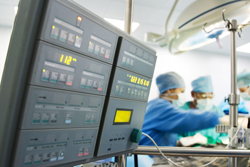Perfecting anaesthesia
General anaesthesia is very often necessary before surgical operations, but it remains a tricky component of surgery that must be monitored closely. There is an acute need to monitor anaesthetic concentrations in the patient's blood stream during surgery. The Intelsens project, fully funded by the EU, set out to develop a new way to monitor the patient's levels of propofol, one of the most common anaesthetics. The project is proposing a gas sensor to identify trace levels of the anaesthetic in the patient's breath. Currently, the effectiveness of propofol-induced anaesthesia is only assessed according to symptoms presented by the patient. The ability to monitor exhaled trace levels of propofol in patients does not currently exist but would dramatically improve the level of control over its administration. The project team succeeded in developing a new optical sensing concept to trace levels of propofol in the breath. This is expected to improve healthcare quality by tailoring dosage to individual needs, while reducing clinical recovery times and postoperative care, along with associated costs. Upon injection, propofol is transported into the blood stream and traces of the drug appear in the exhaled breath. In medical feasibility studies using mass spectrometry and gas chromatography the volume of propofol in parts-per-billion had previously been estimated but the techniques were unsuitable for surgery. After many tests using ultraviolet and infrared rays to measure propofol, the team elaborated the most optimum strategy for optical detection of the drug. The technology relied on what is known as photoacoustic spectroscopy (PAS), built to measure ultraviolet absorption. Laser excitation was also used in the process, and successful equipment was ultimately developed and fine-tuned. The project proved the concept beyond doubt and was accomplished through active collaboration between physicists, chemical engineers, medical professionals and commercial medical systems developers.The results have raised interest in other research institutes and industrial systems manufacturers. A follow-up project is aimed at a clinical evaluation of the PAS technique for online propofol monitoring in patients undergoing surgery. The novel techniques have also shown great potential beyond the current application in fields such as atmospheric trace gas sensing, exhaled breath disease diagnostics, industrial process monitoring as well as pollutant detection in the liquid phase.







